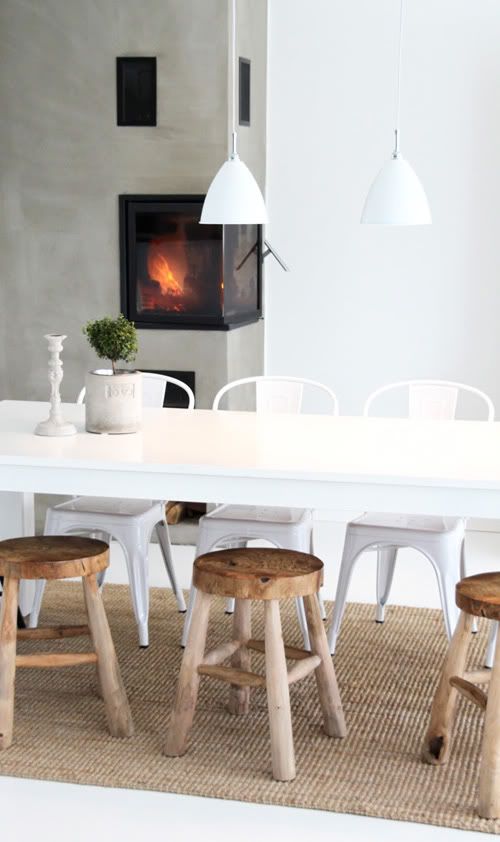Paulistano Armchair 1957 (could this be an interpretation of the bo bardi bowl chair?)
color inspirations..
It's all about the DETAILS

I love the wood bench built around the flat files that also becomes a perfect corner desk - brilliant use of space and great cover up of metal cabinetry! Notice the amazing fluorescent lighting fixture in the pic below.

(image: dwell, architect: Nathan Lee Colkitt)
perfect diy sofa




Sofa and armchair design by James Perse Furniture, the Los Angeles Collection. (image: James Perse)
(images: dwell).
Paola Antonelli treats design as art
Paola Antonelli, design curator at New York’s Museum of Modern Art, talks about her appreciation of design -- in all shapes and forms -- around the world.
Filmed in 2007.
monumental art in the post communist era
Monuments may not be in fashion any more... they used to be commissioned by a king, an emperor, or the Communist Party, but since the breaking of the Eastern European block all that left as a reminder of the bygone era are the futuristic sculptures of artists like, Dušan Džamonja, Vojin Bakić, Miodrag Živković, Jordan and Iskra Grabul, and architects Bogdan Bogdanović and Gradimir Medaković.
In the 1960's and 70's the Yogoslavian president Josip Broz Tito ordered these as commemoration of WWII battles that took place where the monuments stand alone today... here's a selection from Jan Kempenaers' photo tour from Croatia, Serbia, Slovenia, Bosnia and Herzegovina during 2006-2009.
the Italian design tradition: LINA BO BARDI and PAOLA LENTI
 |
| The Sao Paolo Recreational Center, 1977-1986 |

She designed the Sao Paolo Museum of Art (1968), SESC Fábrica da Pompéia or the Sao Paolo Recreational Center (pictured left, completed 1986) , and is known for her own glass house (Philip Johnson completed his CT glass house in 1950), which she built as her residence in 1951, after receiving her Brazilian citizenship. The house is set amongst the old Brazilian forest and rare plant species on a 7,000 sq meter property overlooking Sao Paolo. A beautiful setting...
But she also designed furniture and her most famous creation is the BOWL chair from 1951.
Lenti's furniture seem equally minimal in design and inventive in materials. Designers Patricia Urquiola, Eliana Gerotto created for Paola Lenti a Nido chair, which is directly hand woven on to the structure with a round rope. The simplicity of the thin, elegant base, and the roundness of the shell are much too inviting.
Through this craftsmanship a few things are achieved here simultaneously: durability, homogeneity, and certain intimacy that can only be achieved in products that are handmade.
Here's more on Lenti and her designs..
More reading on Lina Bo Bardi, check out this great article in AFTERALL, ‘This Exhibition Is an Accusation’: The Grammar of Display According to Lina Bo Bardi, by Roger M. Buergel.
 |
| Lina Bo Bardi Bowl Chair, 1951 |
 |
and more examples of Lenti's designs...
![[paola-lenti-crate-bed-ease-4.jpg]](https://blogger.googleusercontent.com/img/b/R29vZ2xl/AVvXsEgQVSlOHyMDffID0cgWquAvoAYCnM-j9va2nteFGrSFaJjOsMh4B3kYPBvDmRI6uQW7tedgXZXsoGmCqXyf24C9Rr3apcnTGYukkuaA1FuzpA2daOfWvI3ughnSk7v8ftvQiy-oRvh3TVQ/s1600/paola-lenti-crate-bed-ease-4.jpg)
![[paola-lenti-soft-furnishings-float-1.jpg]](https://blogger.googleusercontent.com/img/b/R29vZ2xl/AVvXsEgXx9vkMJT8refGkWV-Mv5KE86WFD7Mc4938K9A1yu7zGmeLmYV8gn4Vqmb7ZhnOrMxi1Di-XsoaZ3iWlO2OJ7VqJaqyq18xubVZM9D9IvSi2HUG1lp0QscpZ3ArEosDBkHi_SHRsj6z7U/s1600/paola-lenti-soft-furnishings-float-1.jpg)
![[paola-lenti-outdoor-soft-pouf-play-4.jpg]](https://blogger.googleusercontent.com/img/b/R29vZ2xl/AVvXsEhv1fHi6BoZpYboCwhy6_UyozneqNzPze0-_WZbRSn4AGER-nXRUhS3KHRds11rYeguZA3JtSAPQ9BNKsNyGJoPwd8p33E1qFisamLOELNj3gSlibB5P0A6wOUyb3fLmAgqc9FaF6nBdNU/s1600/paola-lenti-outdoor-soft-pouf-play-4.jpg)
![[paola-lenti-outdoor-soft-pouf-play-1.jpg]](https://blogger.googleusercontent.com/img/b/R29vZ2xl/AVvXsEhpJ3pF1YDE8mcxQazbI8jb52SoxbnI6VKbtmCkaJiWes25h_Yo3zalIHCyiwGMP144Dlr45bniWjNghFfJDISyzzrG36HI3dotqKqNeFZ7ku_dzci_1xZLEmWTDVJvcid3JTo2yx2gRnw/s1600/paola-lenti-outdoor-soft-pouf-play-1.jpg)

the minimalist approach to art
 |
Installation view of Goshka Macuga's "It Broke from Within." at the Walker Art Center, Minneapolis. Photo by Gene Pittman. |
I am often attracted to minimalist forms and spaces. It probably comes from a desire for simplicity and order... There is a fine line in achieving a space that is minimal yet one that 'feels' intimate and not austere. Also, the look of the tapestry covering an entire wall is appealing to me...
From The Walker Art Center: "Polish born and English based artist GOSHKA MACUGA explores ways in which modern and contemporary art forms and museums have engaged evolving ideas of politics and community. Within a physical space of her own design—inspired by a rendering of a "town square" lounge proposed for the Walker's 2005 Herzog & de Meuron expansion—the artist has arranged elements from the institution's collections and archives against a monumental new tapestry."
Another Polish artist carrying on the minimalist approach is sculptor and installation artist, MONIKA SOSNOWSKA. Chosen for the 52nd. Venice Biennale representing the Polish Pavilion in 2007, Sosnowska's installation created of steel posts is reminiscent of a structure out of post war Easter Europe, or the Gdansk Shipyard.. The mat black bones revel bends and twists and angles and reflect their frail design. The minimalist aspect of this work accentuates the obvious failures in architecture and proposes its mistakes as symbols for practices where we want to look for poetry.
 |
Monika Sosnowska, Installation view, '1:1', Venice Biennale, Polish Pavilion, Venice, Italy, 2007 Photo Jan Smaga |
Subscribe to:
Comments (Atom)




















